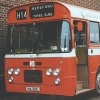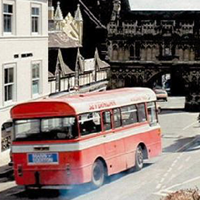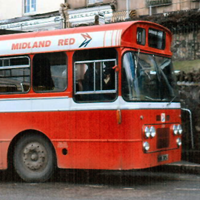Midland “Red” Motor Services (BMMO & MROC)
Ford R192 / R1014 — Miscellaneous Information
Vehicles Shortened by Midland Red Omnibus Company Limited (MROC)
In 1977, Midland Red Omnibus Company Limited (MROC) were conducting their Viable Network Project (VNP) route surveys and the need for smaller buses on certain routes was identified. Following this, on Saturday 23rd July 1977, the company introduced three Ford Transit minibuses for the new “Wayfarer” network of services in Evesham and revisions to the “Reddibus” network of services in Redditch, but these vehicles were soon found to be inadequate.
By September 1977, a number of Ford R192 type F1 buses were scheduled for disposal and as an experiment one such vehicle, fleet number 6391 (registration number YHA391J), was taken to Midland Red’s Central Works and shortened to make a twenty-seven seat midibus. The shortening work involved removing the whole bodywork and shortening the chassis by cutting out sections from the wheelbase and behind the rear axel. To assist weight distribution, the fuel tank and batteries were move to the rear. The original bodywork was overhauled and modified by having two whole bays removed from the relevant places, and the emergency door moved to a new position if front of the offside rear wheel, before being refitted.
This experimental vehicle re-entered service at Redditch depot in December 1977, and was evaluated on local Service R15 and Service R16. The converted vehicle was found to be very successful and over the next two years, Midland Red shortened an additional eleven vehicles for their own use. These replaced all of the Ford Transit type M1 minibuses at Redditch depot and Evesham depot, and several were also allocated to Worcester (Padmore Street) depot for use on local Malvern services following the introduction of the “Severnlink” MAP scheme on Saturday 13th January 1979.
In 1979, Mr Rogers of Central Works was awarded the British Empire Medal in recognition of his innovation and expertise in these conversions. The Lord Lieutenant of the County presented the award at a ceremony in the central workshop. As part of the celebrations, and in recognition of their contributions to the project, all Central Works staff were invited to the award and provided with light refreshments, with senior staff being taken for dinner, and the remaining given the afternoon off work!
Midland Red Omnibus Company Limited (MROC) also offered these conversions to other National Bus Company (NBC) subsidiaries that were looking for small capacity vehicles, and estimated they could convert 20 such vehicles per year. Vehicles were offered with a full chassis overhaul, reconditioned units, body overhaul, repaint to the purchasing company’s livery, and a Certificate of Fitness for a minimum of 5 years. However, demand was not very strong and only four vehicles were converted, two for Western National, one for City of Oxford, and one for Alder Valley.
Vehicles Converted
- Ten type F1 Fords, fleet numbers 6359–6362 and 6388–6393, had all been shortened by the end of 1979, and reclassed to type M2.
M2 conversions, 6359 & 6362, passed to Western National Omnibus Company, and 6393 passed to City of Oxford in 1979, without being operated as type M2 by Midland Red Omnibus Company. - Four type F3 Fords, fleet numbers 369–372, had been shortened by the end of 1979, and reclassed to type M3.
- One type F3 Ford, fleet number 373, had its bodywork removed and chassis shortened in August and September 1980, but the conversion was abandoned before completion (see below) and the chassis was never re-bodied. The chassis was stored for around 5 years at Central Works before being scrapped.
- None of the type F2 Fords were shortened.
- Midland Red Omnibus Company Limited (MROC) shortened an ECW-bodied Ford R1014, registration number TRD725N, for Alder Vally.
In 1978, Buckinghamshire County Council places a 5-ton weight restriction on Marlow Bridge following concerns that the bridge was shuddering under the weight of heavy vehicles. Alder Valley responded by using a 18-seat minibus on their number 18 service across the bridge to Maidenhead, but the seating capacity was found to be insufficient. On Thursday 12th October 1978, the company trialed Midland Red’s shortened Ford R192 fleet number 6389 (YHA389J) on this route, and the success of this lead to the conversion of Alder Valley’s own vehicle.
Related Pages
Summary
Despite the initial enthusiasm surrounding these conversions, history has shown that they were not successful, and the converted vehicles were hugely unpopular with drivers for several reasons. The standard vehicle had a reputation for being nose-heavy due to the front mounted engine and shortening the chassis only made matters worse. With so much of the weight at the front they often struggled for grip at the rear, especially in the wet, and the floor-hinged brakes were erratic, causing the front to nosedive even under light braking. In addition to the handling problems, the Fords were also the only vehicles in the fleet with manual gearboxes. Changing gear was said to have been a total lottery as the gear linkage was so vague that you were lucky if you found the correct gear, although earlier vehicles with the five-speed box were more manageable in this respect.
All but three of these vehicles were withdrawn in 1980, just over 2½ years after the first experimental vehicle entered service at Redditch depot. However, two examples at Evesham depot did manage to outlive Midland Red Omnibus Company Limited (MROC) and passed to Midland Red (West) Limited at the formation of the company on 6th September 1981.
It would be unfair to blame the short service lives of these vehicles on design shortcomings alone as other factors, beyond the control of the engineers, has a significant contribution in their demise. In Redditch, the shortened Fords had been used on Services R15 and R16 to gain access to the Smallwood area of the town, but in 1980 this section of those routes was abandoned which allowed a Leyland National to be used, and other routes that occasionally used the vehicles to Upper Bentley, Feckenham and Inkberrow were withdrawn soon after. Another contribution factor, and probably the most significant, was the archway across the Abbey Road in Malvern…
Abbey Road Archway and the demise of the Short Fords
Prior to its closure on Friday 1st October 1976, all local Malvern services were operated from Malvern (Spring Lane) depot and these services started and terminated at the Post Office in Abbey Road, Great Malvern. Abbey Road is not very traffic friendly as it joins Church Road for a very steep climb to Worcester Road at one end, and has low historic archway that vehicles needed to pass under for access from the other end.
Use of the Post Office stop had gradually reduced from May 1970 with the introduction of one-man operation, as the driver’s view from the junction at the top part of Church Street is completely obstructed by the narrow angle and steep incline. Conductors were therefore required to stand on the corner of the junction (but in practice, often in the open doorway of the bus) to see if it was clear to proceed, and in some cases if the bus was unable to do a hill-start they had to stop traffic. With this in mind, services had departure points moved to Belle Vue Terrace near the Mount Pleasant Hotel when they were converted to one-man operation.
After the closure of Malvern depot all services in the area were withdrawn and replaced, in part, with a new network operated by Worcester (Padmore Street) depot. Vehicles used on the new local Malvern services were interworked with Service 412 from Worcester to save dead mileage, and as this was a major trunk route many journeys would use Leyland National single-deck buses. The roof pod made these vehicles too high to pass under Abbey Road archway so the new network was designed to avoid both this and the junction at the top of Church Road.
In 1978, Midland Red Omnibus Company Limited (MROC) instigated their Market Analysis Project (MAP) in Worcestershire, and the results showed a strong demand for the return of bus services calling at the Post Office in Abbey Road. This is quite understandable as these stops are in the centre of town and without them, the mostly elderly population of the town must negotiate the steep hill in Church Street when walking to and from the alternative stops in Graham Road or at Belle Vue Terrace on the Worcester Road. Also, with services terminating at Belle Vue Terrace buses needed to run out-of-service to Wells Common to turn around for their next service, creating a lot of dead mileage.
The shortened Ford R192 midibuses were believed to be ideal for this as loadings in the town were light, the vehicles could just squeeze under the low archway, and being overhauled during conversion they also had a good life expectancy. So when the “Severnlink” MAP scheme commenced on Saturday 13th January 1979 another new network of local services in Malvern was introduced, resurrecting the use of “M”-prefix service numbers, that made use of the short Fords operating local Malvern services underneath the archway in Abbey Road. The services operated with the Shortened Fords were not interworked with services from Worcester and were used on Service M1 serving Malvern Link, Belmont, Great Malvern (Post Office), Sherrards Green, Barnards Green, Brook Farm and Fruitlands. One Shortened Ford was also used Service M7 and Service M8 between Great Malvern, Colwall and Ledbury.
From the start there were problems as the small vehicles struggled to cope and, for example, Service M1 to Poolbrook and The Fruitlands would often run with a duplication bus during peak-time hours. After only about six weeks of operation of the new services a lorry got itself stuck under the archway causing some damage, and the local authorities seized this opportunity as an excuse to renovate the archway. For several months the archway closed to all traffic while the work was carried out, but unfortunately when the archway reopened it was quickly discovered that by removing the old weathered decorative stone and replacing it with new, the headroom under the archway had been lowered and the vehicles could no longer fit. The temporary diversions became permanent and Church Road in effect became a one-way street to buses as they could neither turn onto Worcester Road at the top without a conductor, nor exit via the archway in Abbey Road, and thus the good people of Malvern lost their bus service to the Post Office forever.
Once the size restrictions had been lifted from services in Malvern the Shortened Ford R192 midibuses suddenly became redundant. This must have been very embarrassing for the company as considerable investment would have been made into converting buses that, after just a few weeks service, no longer had any practical use. Also, expected sales to other National Bus Company (NBC) companies had not materialised with only four orders received. Needless to say, the vehicle shortening project was abandoned.




